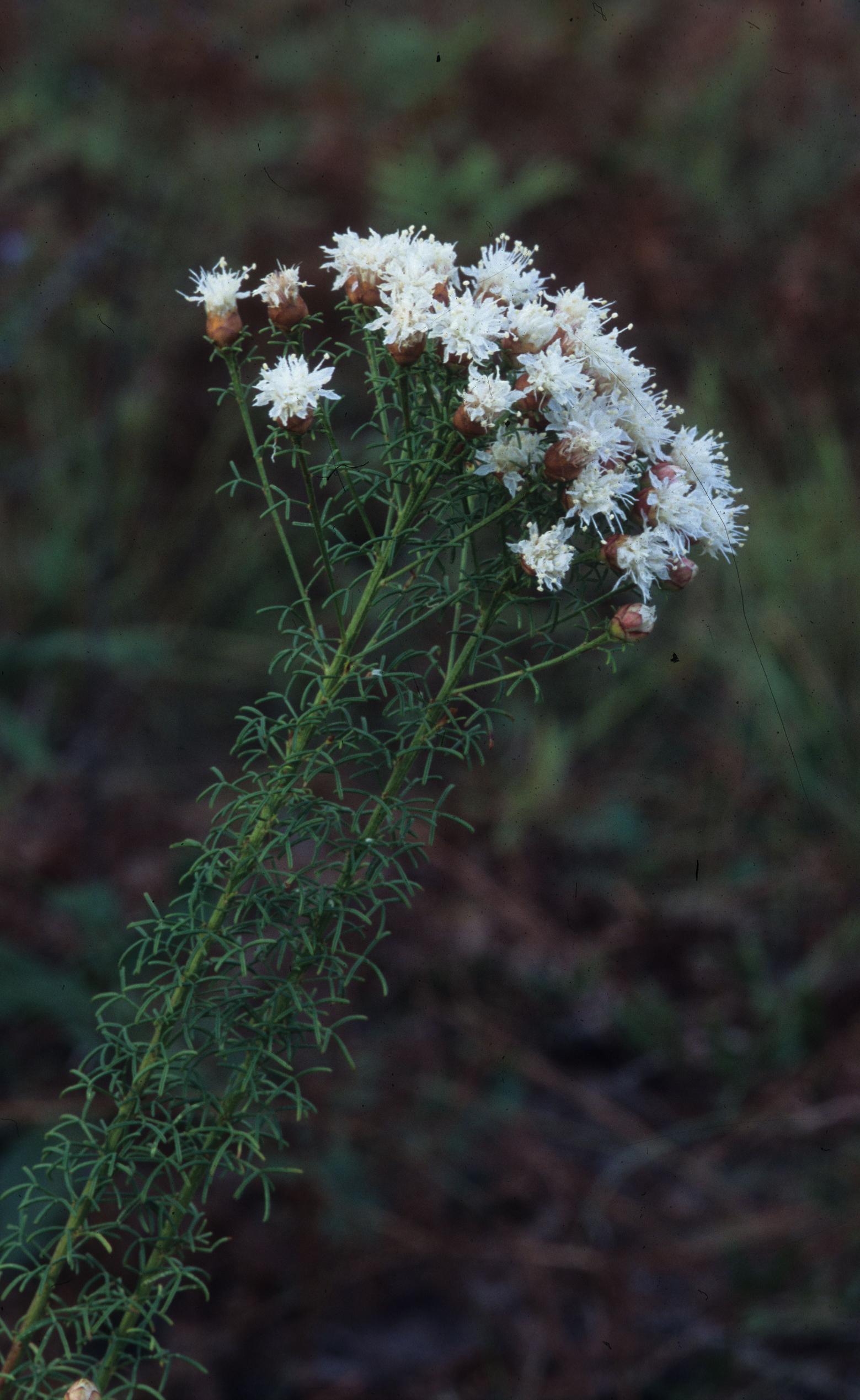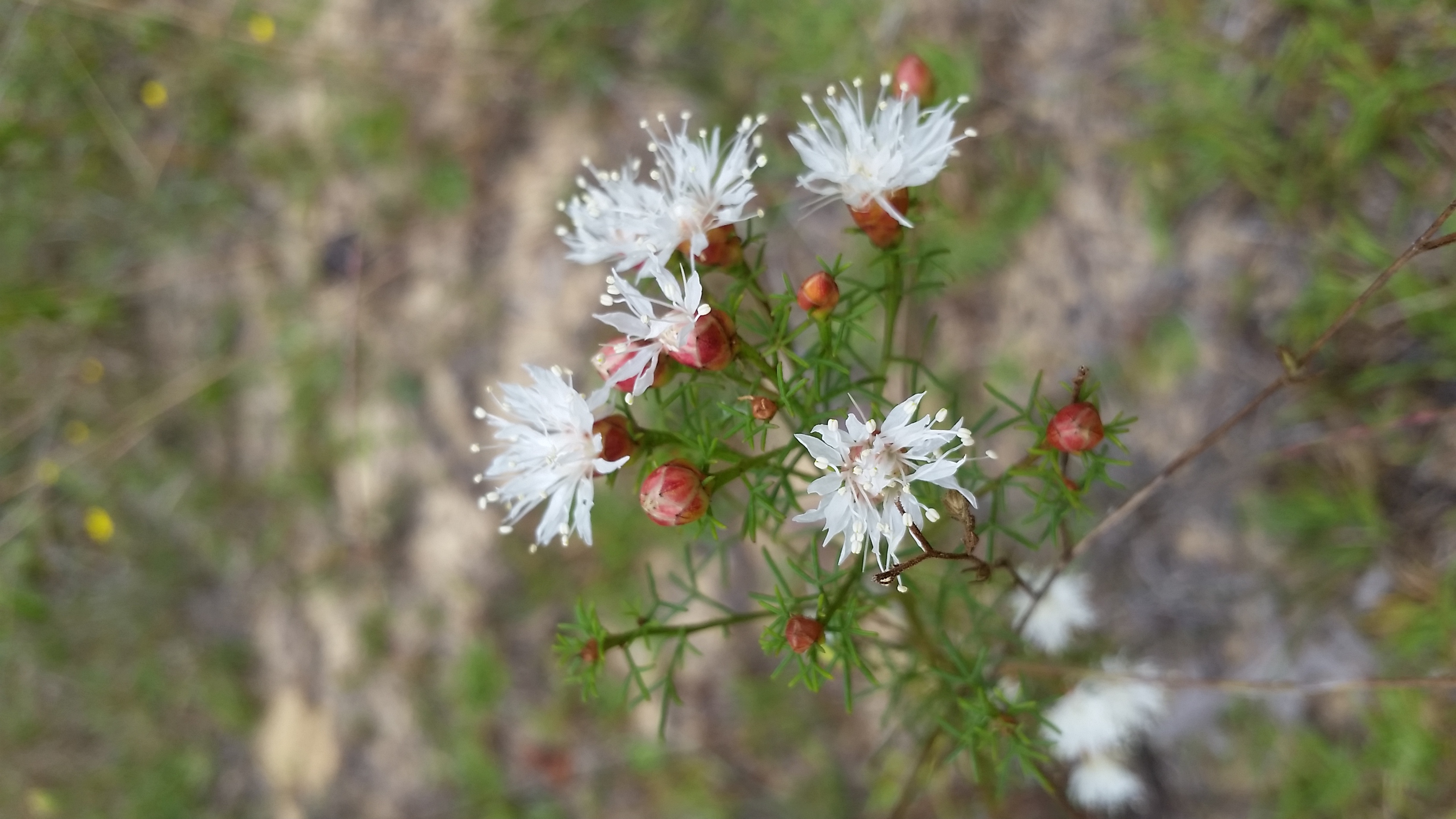Dalea pinnata
| Dalea pinnata | |
|---|---|

| |
| Photo was taken by Gil Nelson | |
| Scientific classification | |
| Kingdom: | Plantae |
| Division: | Magnoliophyta - Flowering plants |
| Class: | Magnoliopsida – Dicotyledons |
| Order: | Fabales |
| Family: | Fabaceae ⁄ Leguminosae |
| Genus: | Dalea |
| Species: | D. pinnata |
| Binomial name | |
| Dalea pinnata (J.F. Gmel.) Barneby | |

| |
| Natural range of Dalea pinnata from USDA NRCS Plants Database. | |
Common name: summer farewell, eastern prairie-clover
Contents
Taxonomic notes
Synonyms: Petalostemum pinnatum (J.F. Gmelin) Blake; Petalostemon pinnatus (J.F. Gmelin) Blake ssp. trifoliatus (Chapman) Wemple[1]
Varieties: Dalea pinnata (J.F. Gmelin) Barneby var. pinnata; Dalea pinnata (J.F. Gmelin) Barneby var. trifoliata (Chapman) Barneby[1]
The Latin name refers to the finely pinnate leaves.[2]
Description
Dalea pinnate is a perennial member of the pea family (Fabaceae) that can be up to 2 feet tall. The stems are smooth and branched with pinnately compound leaves typically <1 inch long. The bright white, hairy, tight grouped flowers show up in the fall between August and November, and the seed pods contain a single seed.[3][4][5]
Distribution
Summer Farewell is distributed across the central portion of longleaf pine forest range from North Carolina south to Florida and west to Alabama. It prefers well-drained soils.[6][7][8]
Ecology
Habitat
D. pinnata occurs in longleaf pine-scrub oak sandhills, pine flatwoods, pine-palmetto barrens, turkey oak sand ridges, sand scrubs, lake edges, and on grassy slopes near bogs. Is also found in human disturbed areas such as roadsides, fields,and forest edges. It can grow in sand, sandy loam, and sandy clay.[9] It was found to be among the most cold-hardy legumes found in southern Georgia, where it persists through repeated frosts and was present in January and February field surveys.[10]D. pinnata was found to become absent in response to soil disturbance by military training in west Georgia. It has also shown resistance to regrowth in reestablished longleaf pine forests that were disturbed by military training.[11]
Associated species includes Pinus palustris, Quercus incana, Quercus laevis, Chrysopsis gossypina, Pityopsis aspera, Sorghastrum nutans, Rubus cuneifolius, Liatris gracilis, Lechea, Sericocarpus tortifolius, Solidago odora, Eupatorium album, and Trichostema dichotomum.[9]
Phenology
It has been observed flowering August to November and fruiting in October.[9][12]
Seed dispersal
This species is thought to be dispersed by gravity.[13]
Seed bank and germination
This species is capable of forming soil seed banks with seed dormancy capable of being broken through scarification. Light is not required for germination[14].
Fire ecology
It is associated with frequently burned areas[9].
Pollination
Summer Farewell is attractive to pollinators such as bees and butterflies due to its nectar. The plant is a larval host for the southern dogface (Zerene cesonia), and birds and small wildlife are known to consume the seeds.[15][16][17] Hall and Ascher (2014) observed Trachusa fontemvitae and 9 species of Megachilidae on D. pinnata at the Ordway-Swisher Biological Station in North-Central Florida.[18] Additionally, D. pinnata was observed to host a variety of pollinators, including bees such as Bombus impatiens (family Apidae), plasterer bese such as Colletes howardi (family Colletidae), sweat bees from the family Halictidae such as Augochloropsis metallica and Lasioglossum apopkense, skippers such as Euphyes arpa (family Hesperiidae), and leafcutting bees from the family Megachilidae such as Anthidiellum notatum, Anthidiellum perplexum, Megachile albitarsis, Megachile georgica, Megachile pseudobrevis, Megachile texana and Trachusa fontemvitae, butterflies such as Phoebis sennae (family Pieridae), and scoliid wasps such as Campsomeris quadrimaculata (family Scoliidae).[19]
Conservation, cultivation, and restoration
D. pinnata should avoid soil disturbance by military training to conserve its presence in pine communites.[11]
Cultural use
Photo Gallery
References and notes
- ↑ 1.0 1.1 Weakley, A.S. 2020. Flora of the Southeastern United States. Edition of 20 October 2020. University of North Carolina at Chapel Hill, Chapel Hill, North Carolina.
- ↑ [[1]]Native Florida Wildflowers. Accessed: April 16, 2016
- ↑ Denhof, Carol. 2019. Plant Spotlight Dalea pinnata (J.F. Gmelin) Barneby var. Pinnata Summer Farewell. The Longleaf Leader. Vol. XII, Issue 3. Pg. 7
- ↑ "Dalea pinnata". Florida Native Plant Society. 2013. https://www.fnps.org/plants/plant/dalea-pinnata Sorrie, B.A. 2011. A Field Guide to Wildflowers of the Sandhills Region. The University of North Carolina Press. Chapel Hill, NC. 378pp.
- ↑ USDA, NRCS. 2019. The PLANTS Database (http://plants.usda.gov, 9 August 2019). National Plant Data Team, Greensboro, NC 27401-4901 USA.
- ↑ Denhof, Carol. 2019. Plant Spotlight Dalea pinnata (J.F. Gmelin) Barneby var. Pinnata Summer Farewell. The Longleaf Leader. Vol. XII, Issue 3. Pg. 7
- ↑ "Dalea pinnata". Florida Native Plant Society. 2013. https://www.fnps.org/plants/plant/dalea-pinnata Sorrie, B.A. 2011. A Field Guide to Wildflowers of the Sandhills Region. The University of North Carolina Press. Chapel Hill, NC. 378pp.
- ↑ USDA, NRCS. 2019. The PLANTS Database (http://plants.usda.gov, 9 August 2019). National Plant Data Team, Greensboro, NC 27401-4901 USA.
- ↑ 9.0 9.1 9.2 9.3 Florida State University Robert K. Godfrey Herbarium database. URL: http://herbarium.bio.fsu.edu. Last accessed: October 2015. Collectors: R. A. Norris, R. Komarek, Robert K. Godfrey, P. Genelle, G. Fleming, L. J. Brass, O. Lakela, Cyrus Darling, Paul M. Cassen, Robert Kral, John Morrill, R. E. Perdue, Jr., Andre F. Clewell, Leonard J. Brass, Daniel B. Ward, Sidney McDaniel, Gary R. Knight, Cecil R Slaughter, David Hall, Gary Schultz, Loran C. Anderson, Jean Wooten, John B. Nelson, S. Bennett, William B. Fox, Harry E. Ahles, M. Garland, R. D. Houk, Kurz, Dennis Hardin, C. Chapman, S. Chapman, Cindi Stewart, - MacClendons, Eula Whitehouse, Delzie Demaree, Michael B. Brooks, and Channell. States and Counties: Alabama: Mobile and Pike. Florida: Bay, Citrus, Clay, Collier, Columbia, Dixie, Escambia, Franklin, Gadsden, Highlands, Jackson, Jefferson, Leon, Liberty, Madison, Palm Beach, Pinellas, Putnam, Santa Rosa, Seminole, Suwannee, Taylor, Wakulla, and Walton. Georgia: Baker and Bulloch. Mississippi: Hinds, Jackson, and Perry. North Carolina: Cumberland, George, and Robeson. South Carolina: Colleton.
- ↑ Hainds, M. J. (1995). Legume population dynamics in a frequently burned longleaf pine-wiregrass ecosystem. Master of Science Thesis, Auburn University. 111 pages.
- ↑ 11.0 11.1 Dale, V.H., S.C. Beyeler, and B. Jackson. (2002). Understory vegetation indicators of anthropogenic disturbance in longleaf pine forests at Fort Benning, Georgia, USA. Ecological Indicators 1(3):155-170.
- ↑ Nelson, G. PanFlora: Plant data for the eastern United States with emphasis on the Southeastern Coastal Plains, Florida, and the Florida Panhandle. www.gilnelson.com/PanFlora/ Accessed: 19 MAY 2021
- ↑ Kirkman, L. Katherine. Unpublished database of seed dispersal mode of plants found in Coastal Plain longleaf pine-grasslands of the Jones Ecological Research Center, Georgia.
- ↑ Perez, H. E., F. Almira, et al. (2009). "Germination Timing and Dormancy Break in Seeds of Summer Farewell (Dalea pinnata, Fabaceae)." Ecological Restoration 27(2): 160-168.
- ↑ Denhof, Carol. 2019. Plant Spotlight Dalea pinnata (J.F. Gmelin) Barneby var. Pinnata Summer Farewell. The Longleaf Leader. Vol. XII, Issue 3. Pg. 7
- ↑ "Dalea pinnata". Florida Native Plant Society. 2013. https://www.fnps.org/plants/plant/dalea-pinnata Sorrie, B.A. 2011. A Field Guide to Wildflowers of the Sandhills Region. The University of North Carolina Press. Chapel Hill, NC. 378pp.
- ↑ USDA, NRCS. 2019. The PLANTS Database (http://plants.usda.gov, 9 August 2019). National Plant Data Team, Greensboro, NC 27401-4901 USA.
- ↑ Hall, H. G. and J. S. Ascher (2014). "The Distinctive Bee Fauna (Hymenoptera: Apoidea: Anthophila) of Sandhill Habitat at the Ordway-Swisher Biological Station in North-Central Florida." Journal of the Kansas Entomological Society 87(1): 1-21.
- ↑ Discoverlife.org [2]
